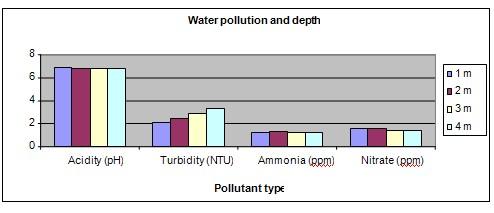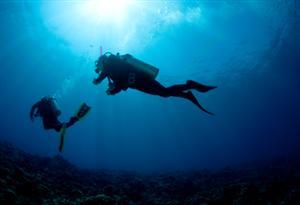| Complexity level: | 7 |
| Project cost ($): | 120 |
| Time required: | 1 day to prepare, 1 day for observation |
| Material availability: | Access to laboratory equipment |
| Safety concerns: | Scuba diving safety protocols and water safety measures to be strictly observed at all times. Should be performed only by an experienced adult. |
Hypothesis
A water sample taken from deeper waters will contain less pollutant.
Overview
Water pollution
Rivers, lakes and oceans become polluted when foreign substances are released into these bodies of water before treatment to remove these contaminants has taken place. Our rivers and lakes are an important source of drinking water. They are also an important source of water for animals living in these habitats. When water is polluted, the entire ecosystem is affected. Polluted water is also unfit for agricultural and industrial use.
During heavy rainfall, pollutants in the surrounding catchment area are washed into lakes and rivers. These pollutants are a result of agricultural and industrial waste including fertilizers, insecticides, loose soil, organic material, chemicals and much more. When land is cleared for farming or development, the top layer of the soil is washed into the rivers and lakes. This causes a higher level of sedimentation in the water and affects the turbidity of the water.
In areas that are populated, water pollution arises in the form of domestic sewage, namely waste water discharged as a result ofhousehold activities such as washing clothes, showering or washing dishes. This waste water contains detergents, fat, grease and other household waste. The waste is discharged into the rivers through a network of drains and they eventually end up in the lakes or the ocean.
Scientific Terms
Materials
The materials required for this science fair project:
- A set of diving gear
- An experienced diver
- 20 empty bottles, approximately 100ml each, to be used to collect water samples
- Adequate supply of pH paper
- a turbidity meter (these are pricey and you should therefore try to gain access to one from a test lab, or alternatively, check if your local utilities board is able to help with the testing. Handheld units start at several hundred dollars.)
- 1 freshwater test kit (these are inexpensive and may even be purchased online, from NexTag or other large retailers)
- 1 marker pen (waterproof ink)
Procedure
1. For this science fair project, the independent variable is the depth at which the water sample is taken i.e. 1 meter, 2 meters, 3 meters and 4 meters. The dependent variables are the pH reading, turbidity, ammonia content and the nitrate content of the water sample. This is determined by using pH paper, the turbidity meter and the freshwater test kit.. The constants (control variables) are the amount of water taken and the depth at which the water samples were obtained.
2. You will need the scuba diver to gather the water samples at 4 different depths. The diver will probably have the experience to help you identify a suitable lake with depths up to 4 meters, rent a boat and rent the appropriate diving gear.
3. On the chosen day, a trip is made with the diver to the suitable diving spot. Ensure that safety procedures are properly followed and life jackets should be worn at the appropriate time, The 4 bottles are labeled “1 meter”, “2 meters”, “3 meters” and “4 meters”. You can either use a labeller that prints on waterproof tape, or alternatively you can write directly onto the bottles with a waterproof marker. The diver will dive into the lake and obtain water samples from the required 4 different depths. Ensure that he collects 20 samples at each depth, from different locations within the lake.
4. Collect the bottle samples from the diver and visually inspect the water in the bottles. Ensure that the marking on the bottles are still clear.
5. The 20 bottles of water samples are to be brought back to a lab for testing. They are tested for acidity with the pH paper and the turbidity meter will be used to test the turbidity of the water. The fresh water test kit will be used to check for levels of nitrate and ammonia. The results of the tests are recorded in the table below.

Results
It is observed that the levels of acidity, ammonia content and nitrate found in the water samples did not change significantly regardless of the depth at which these samples were obtained. However, the turbidity of the water increased as the depth of water increased.
| Water depth | Tests done on water samples | |||
| Acidity (pH) | Turbidity (NTU) | Ammonia (ppm) | Nitrate (ppm) | |
| 1 meter | 6.9 | 2.1 | 1.2 | 1.4 |
| 2 meters | 6.8 | 2.4 | 1.3 | 1.5 |
| 3 meters | 6.8 | 2.9 | 1.2 | 1.4 |
| 4 meters | 6.8 | 3.3 | 1.2 | 1.4 |
The graph below represents the results of our science fair project experiment:

Conclusion
The hypothesis that a water sample taken from deeper waters will contain less pollutants is proven to be incorrect.
It is important to maintain the quality of our fresh water resources and to ensure that they are free from polluting substances. This is to ensure there is enough clean water for our future generations. We also have the responsibility to ensure the survival of plants and animals which depend on these same water resources . It is our responsibility not only to make sure that waste water is treated before being released back into the environment, but also to mimize water pollution. Through a combination of better education, promoting the use of eco-friendly products and ensuring the proper disposal of household waste, we can do much to prevent the contamination of our precious sources life-sustaining water.
Also consider
What would happen if this science fair project were to be repeated with water samples taken from rivers or oceans?
The experiment might also repeated by taking water samples from greater depths of 5 meters, 10 meters, 15 meters and 20 meters. Would the water be necessarily more turbid at even greater depths? Or perhaps we should be looking at a bell-shaped curve, where up to a certain depth, the water begins to clear up and register lower turbidity readings?
References
Water pollution - http://en.wikipedia.org/wiki/Water_pollution
Common water measurements - http://ga.water.usgs.gov/edu/characteristics.html
Earth’s water- rivers and sediment - http://ga.water.usgs.gov/edu/earthriverssed.html

